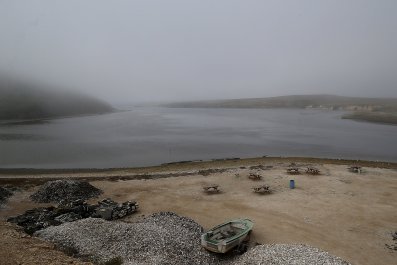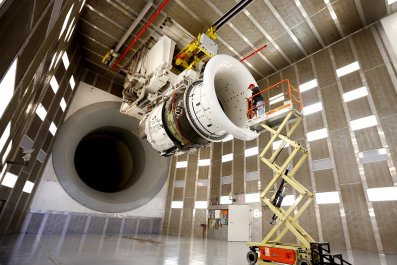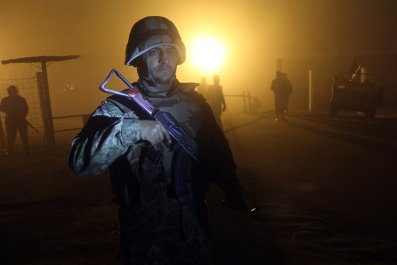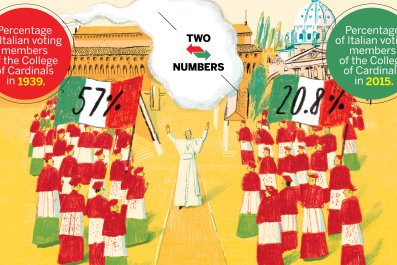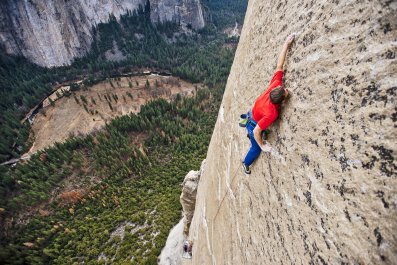The ancient city of Sana'a is one of the oldest continuously-inhabited cities on the planet. Its astounding street markets, almost unchanged since the time of the Prophet, used to attract hordes of Western tourists. Not any more. The risk of kidnap has become too great; the British Embassy advises its nationals to leave the country if possible, and if not, to keep any movement around the capital to an absolute minimum. Walking anywhere in the city these days raises hairs on the back of the neck.
The kidnap of foreigners, usually by hill tribes seeking leverage over the Sana'a government, has a long history in Yemen. It used to be considered bad for business to harm the victims, who were traditionally released unhurt – that has changed too. In a sign of the resurgence of Islamic extremism in the region, kidnappers have started selling their victims to al-Qaida and abducted foreigners increasingly end up dead.
For the last year or more, the West's fear and attention has been focused on the emergence of Isis in Syria and northern Iraq. The Islamic State's ideology, the brutality of its methods, and the success of its territorial campaign have eclipsed al-Qaida, the movement that spawned Isis, but which also formally disavowed them a year ago. Since the death of Osama bin Laden, al-Qaida has seemed divided, directionless; a diminished force.
Its franchise in Yemen, al-Qaida in the Arabian Peninsula (AQAP), was perhaps best known abroad for thwarted attacks on the West, such as that of Umar Farouk Abdumutallab, the so-called underpants bomber, who tried to blow up a plane over Detroit in 2009, or the cargo-planes bomb plot of 2010. But with the group's claim of responsibility for the recent attacks in Paris, however, al-Qaida appears to have made a dramatic international comeback.
In truth, Yemen has always been an al-Qaida stronghold. As the ancestral homeland of bin Laden himself, Yemen is arguably where the movement was born. The first ever al-Qaida attack took place in Yemen, when US Marines staying in two hotels in Aden were bombed in 1992, and, despite some setbacks, al-Qaida has never been extinguished in Yemen since. In 2010, the CIA declared AQAP the most potentially dangerous franchise on the planet. In 2011, the year of Yemen's Arab Spring, AQAP exploited the revolutionary chaos by taking over the southern province of Abyan, which they declared an Islamic Emirate. It took the Yemeni military a year to drive them out again.
In recent times AQAP's targets have been mostly domestic. A suicide bomb attack on a Parade Day rehearsal in May 2012 killed 120, and injured 200 more; a horrendous assault on a defence ministry hospital in December 2013 left 56 dead; on the same day as the Paris attacks, a car bomb outside a Sana'a police college killed 37.
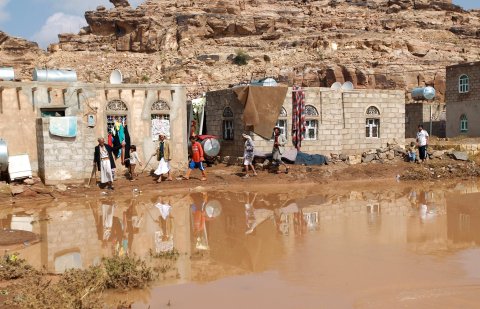
In 2013, when a 10-month, UN-sponsored National Dialogue Conference opened in Sana'a, with the promise of a new constitution ahead of fresh elections in 2015, AQAP's prospects seemed, briefly, to dim. But then, in September, Yemen's transition to democracy was dramatically derailed when disgruntled Shia Houthi tribesmen from the north of the country first surrounded and then took over the capital. With the Houthis continuing to tighten their grip – Houthi fighters today overran the Presidential palace after fierce fighting in Sana'a – all bets on a 2015 election are now off. Instead, with rumours swirling that the Houthis are covertly supported by Iran, the prospect of an Iraq-style sectarian conflict beckons. Renewed instability is a boon to AQAP, who have always fought the 'apostate' Shia Houthi, and have positioned themselves as a logical rallying point for Sunni resistance. Yemen no longer looks like the model of peaceful transition to democracy that it did a year ago, but more like the next Middle East nation to spin violently apart.
Terror's Return
Al-Qaida has a long track record of exploiting sectarian differences. In Yemen, though, it has developed another, more surprising, method of winning tribal hearts and minds: its members have become champion exploiters of the country's chronic water shortage. (The country is one of the five most water-stressed in the world, with just 86 cubic metres available per capita per annum, according to the World Bank. Even drought-prone Somalia has 572 cubic meters available per capita. The UK, by contrast, has 2,262 cubic metres).
In regions south and east of Sana'a, where many communities have been ignored for years by the central government, AQAP has won significant support not just by providing villagers with water, but also by helping them to dig wells and install other vital water infrastructure. Sharia, the Islamic law that al-Qaida is determined to impose, means, in one of its many possible translations, "the path to the water hole" – a metaphor for spiritual salvation with obvious appeal to followers of a religion that originated in the Arabian desert. AQAP is trying to make that metaphor a reality.
This activity goes far beyond social work. In an impoverished farming nation, where over half the population still lives off the land, access to water, and the ability to irrigate crops, is often a matter of life or death. Even government officials estimate that local disputes over land and water already lead to 4,000 deaths every year.
Sana'a is badly affected, too. Supply is already so poor here that municipal taps function on average only once a month. Its 2.6 million residents have long relied on rooftop cisterns filled with water expensively tankered in from elsewhere. According to a study commissioned by the World Bank, the city could be unsustainable as soon as 2019. Unless action is taken soon, Sana'a's residents may be forced to leave the city to wither and die. The wars of the future, it is often said, will be fought not over oil but over water. Yemen offers us a glimpse of the coming apocalypse.
Worse, AQAP is looking to export its water "weapon." In a document discovered by the Associated Press in 2013, addressed to AQIM (al-Qaida in the Maghreb), AQAP suggested trying to win locals over "by taking care of their daily needs like water. Providing these necessities will have a great effect on people, and will make them sympathise with us and feel that their fate is tied to ours." AQAP has identified the provision of water and its infrastructure as a key means of doing this. The United States' former Enemy Number One in the region, the Islamist ideologue Anwar al-Awlaki, who was killed by a US drone strike in 2011, was the holder of a BSc in Civil Engineering from Colorado State University.
AQAP may also have learned from the mistakes of other AQ franchises, such as their neighbours in Somalia, al-Shabaab. The greatest reversal suffered by that organisation came during the southern Somali drought of 2011, which it dealt with by asserting that it existed only in the minds of Western propagandists. Refugees fleeing the drought zones were ordered to return to their homes and to pray for rain. Tens of thousands died as a consequence, and popular support for al-Shabaab collapsed.
Wells, Not Drones
The Sana'a government is miles behind AQAP in its appreciation of the problem. A new strategy for managing the nation's dwindling resource is urgently needed. At the National Dialogue Conference, Yemen's tiny, beleaguered community of hydrologists lobbied hard for their sector to be made a priority – but in this year's spending round, the budget of the ministry of water and environment's National Water Resources Authority (NWRA), was cut by 70%. As Najib Maktari, a senior ministry adviser, put it: "It shows you how little importance Hadi attaches to the sector."
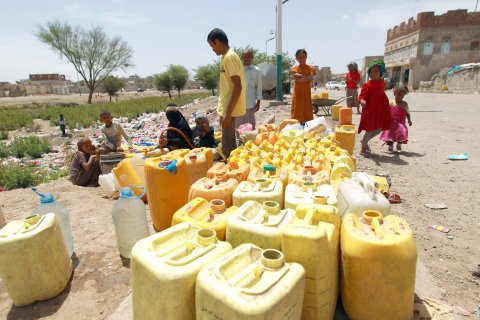
The vast majority of the government's resources is spent on the military, as it has been for years. There are over 400,000 men under arms in Yemen fighting Houthis in the north, separatists in the south, and al-Qaida just about everywhere. They are aided in this last campaign by US drones – though the Yemeni government does not have its own drones, it is widely believed to provide American drone operators with target intelligence. In fact, Yemenis have judged their president such an enthusiast for drone strikes that he has long been nicknamed "Drone al-Hadi." The results of these policies, very much abutted by the strong Western support of al-Hadi's government, have ranged from ineffective to catastrophic.
Mohamed Ali al-Gauli is a schoolteacher from the remote mountain district of Khawlan. His brother and cousin were killed in a US drone strike while driving in their car and, as a reminder of the tragedy, he keeps a scrap of tailfin, complete with American markings, from the missile he holds responsible for the deaths. His brother and uncle, he insists, had nothing to do with AQAP. Their mistake had been to pick up four armed hitch-hikers in the course of a routine shopping trip.
As in Pakistan and elsewhere, the accuracy of the drone strikes used in Yemen has been called into question. A recent study by Reprieve, the New York–based human rights group, which was widely circulated on Yemeni social media, suggested that strikes aimed at 17 named men have so far killed 273 people, at least seven of them children; while at least four of the targets are still alive. "You know, those drones are very expensive," Al-Gauli observes bitterly. "Yet in our village, it takes a 2km donkey ride to fetch water from a well. If someone spent a tenth of the cost of a missile on a well for our village, maybe no-one would pay attention to al-Qaida and they would go away."
The Sana'a administration has made mistakes, but the crisis in Yemen is not all of President al-Hadi's making. At its root, say sociologists, is Yemen's extraordinary population growth, from five million in 1960, to 26 million today, to a projected 40 million by 2030 – numbers that would be a challenge to provide with fresh water even if Yemen were rich and stable. Sana'a, with a population growth of almost 7% – more than double the national rate – faces the greatest challenge. There were fewer than 20,000 people living in the city in 1910. Soon there will be three million. Desalination is not an option for Sana'a, which is both too far from the ocean and, at 2,250m above sea level, too high to make it practical. "For its size, Sana'a is a city in the wrong place," said Brett Grist, a British former consultant to NWRA. "It's as simple as that."
Water for Drugs
Yemen's water crisis has been in pipeline, as it were, for at least 40 years. Until the 1970s Yemenis irrigated their crops as they had always done, with seasonal rainwater captured in elaborate systems of mountain terraces. Increasing demand for food as the population expanded, however, led farmers to seek a more reliable source of irrigation – and they found one in groundwater, pumped up by tubewells from beneath their feet.
The switchover accelerated with the discovery of oil in the 1970s when the government, anxious to increase agricultural production, introduced fuel subsidies to encourage farmers to drill. Without maintenance, much of the beautiful, millennia-old mountain terracing, for which Yemen is famed, was abandoned. It soon collapsed, deepening the farmers' dependence on groundwater.
The political ramifications of that decision are still being felt. There were mass protests by Houthi tribesmen last autumn over the central government's attempt to reduce those fuel subsidies which, now that Yemen's oil is running out, it can no longer afford. The Houthis, though, would not countenance the higher water drilling costs that a subsidy cut would entail. The government quickly reversed their decision, but not quickly enough to avert a coup.

Switching to groundwater irrigation has also been an environmental disaster. Aquifers take time to recharge, but Yemenis aren't giving them a chance. In the Houthi heartland of Sa'adah, for instance, groundwater is being extracted 12 times faster than nature can replace it. Thirty years ago, it was possible to find groundwater at a depth of 100m in the Sana'a basin. Today's drillers sometimes have to go as deep as 1,200m. The shallow, self-replenishing reserves were plundered long ago; the water now being exploited is so-called fossil water that may never be replaced.
Tens of thousands of farmers, forced from their land, have headed for the big city looking for alternative employment where there generally is none. As the Sana'a basin aquifer depletes further, this trickle of displaced farmers looks certain to become a flood.
Perhaps the biggest challenge in conserving the country's dwindling aquifers comes from what is actually cultivated on Yemeni farms. The government's intention, when it first subsidised agricultural diesel in the 1970s, was that farms should produce food. But farmers soon found it much more profitable to grow qat, the amphetamine-like chewing leaf to which Yemen, as a nation, is addicted. An estimated one in three Yemenis, perhaps eight million people, are regular users of the drug, which, although a controlled substance in the West, is legal in Yemen and throughout the Horn of Africa. Yemenis spend, on average, between a quarter and a third of their income on qat, about $4bn a year nationally. According to one Dutch study, the qat business accounts for 16% of employment and 25% of GDP.
Qat trees are deep-rooted and thirsty, and because only the soft, leafy tops of the tree are suitable for consumption, they are notoriously wasteful to grow. Some analyses suggest that 40% of all the fresh water available in Yemen is used in the cultivation of a product that has no nutritional value whatsoever – and this in a country where more than half of all children under five are stunted by malnutrition. Yet the area of land dedicated to the cultivation of qat continues to expand by 10% a year.
Attempts to rein in the trade have all foundered due to insurmountable vested interests. The land-owning tribal sheikhs and military figures who profit most from qat farming tend also to be members of parliament and block any change. When, for example, parliament tried to discuss the import of qat from Ethiopia – a measure designed to undercut local profits, thus reducing the appeal of the crop and therefore the amount of Yemeni land dedicated to it – one MP stood up and announced: "We'll shoot down the planes."
"Our greatest problem in Yemen" adds the deputy chairman of NWRA, Abdulla al-Thary, is that noone ever thinks about the common good. It is always I, I, I and never We, we, we."
The Wildcat Drillers
Private and unlicensed wells continue to be sunk at an astonishing rate by so-called wildcat drillers who own and operate a vast fleet of mobile rigs. Estimates suggest that there are 14,000 privately-owned tube wells in the Sana'a basin today, with more being drilled every day.
The under-resourced water ministry does its best, but has effectively lost the war against the wildcatters, who tend to be employees of the same influential sheikhs who control the qat trade. For example, a government programme to install supposedly tamper-proof GPS transmitters in all known rigs failed when the operators found ways to remove or destroy them. In 2012, NWRA set up a public hotline and encouraged Sana'anis to report any suspicious-looking drilling operation. But the uptake was minimal; and even when NWRA officials turned up to try to prevent an illicit operation, they were quickly chased off by tribal gunmen, or even, on one occasion, by co-opted police.
Recently, Noori Gamal, a senior hydrologist with the water ministry, heard a rumor that a wildcatter was in action in Hadda, the main downtown business district, and invited me to meet him there. I could hear nothing at first, but his experienced ear immediately detected the rumble of a deep hydraulic rotary drill. He lead me three blocks, and there it was: a tall Heath-Robinson contraption in the side garden of a private house belonging (as we later discovered) to a qat-farming, land-owning sheikh. Backed up to the wellhead, blocking the road, was a long, low truck loaded with hundreds of metres of drill pipe. The street was filled from side to side with a waist-high river of drill lubricant that oozed from the borehole, a wobbling mass of soapy white foam through which two boys were pulling wheelies on mountain bikes. Half a dozen labourers stood about, surly and staring, their cheeks distended from the lumps of qat in their mouths.
The foreman of the operation was not pleased to see us, but Gamal soon made it clear he wasn't there to try to stop him. Obstructing a drilling operation, he explained afterwards, had become a perilous business; the sheikh who employed the foreman could manipulate the political system to have Gamal fired, or arrested, or much worse.
"I see unlicensed drilling rigs as mobile artillery batteries, and the tankers that distribute the groundwater as missiles landing in every neighbourhood," Gamal added. "I don't think that language is too strong. What we are doing to our water resource does as much damage to our country as any military campaign and the water shortage is already killing more of our people than al-Qaida ever will."
Off the Precipice
There are no easy solutions in Yemen. Last November, in co-operation with the UN and the Dutch embassy, the water ministry launched a three-year project in the Sana'a basin aimed at persuading its farmers to start conserving their resources, and to pump less groundwater. To the south of the city, meanwhile, where a large aquifer remains untapped, new municipal wells are being sunk. These and other measures can buy Sana'a some time. Yet tapping more aquifer water will only postpone the inevitable. "Yemen is like a man sliding towards a precipice," said a former water minister, Abdul-Rahman al-Eryani. "He will definitely go over the edge. The only question is when."
Not everyone is so gloomy. Some senior officials believe the wholesale change of approach to water management that the country needs is possible, and that they have time. The experience of a community of Ismaili Shia in Haraaz in the western highlands offers some hope. Fifteen years ago they decided to uproot their qat orchards – some 200,000 trees have so far been destroyed – and plant crops of comparable commercial value, notably premium coffee, for which Yemen was once famous. (The Mocha coffee bean takes its name from the Yemeni Red Sea port of that name.) The Ismailis also introduced modern drip irrigation and have begun to repair their water-harvesting terraces. As a result, the Haraaz water table is no longer falling, and the local economy is thriving. Could this brave experiment become a model for the rest of the country?
The chairman of NWRA, Ali al-Suraimi, seems to think so. He believes that even Sana'a could be sustainable if highland farmers reduce their dependence on groundwater. "We need to repair our terraces and go back to the old ways, and to live like our grandfathers did," he says. It is an unhappy paradox, but the future of Yemen, together with its ancient capital, may depend on the ability and willingness of its people to turn back the clock.








